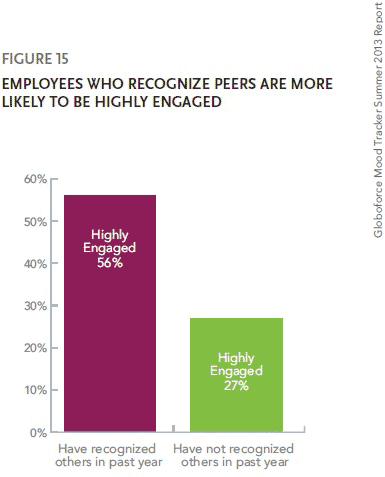Employee recognition is an important form of positive feedback (who doesn’t love being recognized for their efforts after all?!) and a 2013 study by Globoforce gives us even more reason to institute this type of feedback in our organizations.
The study examines the growing intersection between recognition and employee performance and has some noteworthy points. Where recognition is concerned, perhaps the most important point made is that recognition directly impacts business results.
Recognition brings about positive change
- Out of 708 randomly selected fully employed persons in the United States (aged 18 or older) who are employed at organizations with a staff size of 500 or more employees, those who were recognized with values-based recognition reported a positive change in their productivity.
- Additionally, 49 percent of respondents who had experienced values-based recognition indicated a positive change in relationships, 43 percent indicated a positive change in their customer service efforts, and 82 percent stated that being recognized for efforts at work motivated them in their job.
These statistics reinforce the value and importance of recognizing employees, but what I found particularly interesting and a less obvious benefit of employee recognition was how the ability to give vs. receive recognition affected employees. The study found that employees who are empowered to recognize other employees at their organizations were twice as likely to identify themselves as highly engaged; highlighting that value should be placed on allowing employees to give recognition as much as it is placed on making sure employees receive recognition.
More satisfied and likely to remain on the job
Another interesting and less obvious result of employee recognition is the link between recognition and alignment with organizational culture and values.
Of respondents surveyed, 48 percent indicated that receiving recognition when they did something right served to align them with their organization’s values and culture. As I discussed in another recent post, employees who feel strongly aligned with company values and mission are more satisfied with and likely to remain at a job, so this relationship between values and employee recognition is a valuable one to explore.
Employee recognition can also influence employees’ perception of performance reviews. Globoforce’s study found that 76 percent of respondents thought recognition data would make reviews better, and 75 percent of respondents who had been recognized recently stated that they enjoyed their reviews.
The power of crowd-sourced recognition
We can attribute these changes in perception toward reviews to the attributes like engagement and connection with company values, but also to another idea. As the study points out, peer and managerial recognition act as a form of social crowdsourcing, a familiar and comfortable concept for employees who most likely use crowdsourcing programs like Yelp or Amazon regularly.
Some 80 percent of respondents felt that crowd sourced (manager plus crowd sourced peer feedback) to be more accurate. With employee recognition serving as a form of crowd sourced feedback it makes sense then that employees who were recently recognized felt more comfortable in reviews.
But why does it matter if employees enjoy their reviews? The research shows that employees who are satisfied with reviews are more highly engaged, less susceptible to job poaching, and more satisfied with their job.
The key to a healthy domino effect
This data show that creating a system that gives employees feedback from peers as well as from managers – feedback that is values-based – is the gift that keeps on giving. To employee engagement, to higher retention, to financial performance. Who doesn’t want that gift under the tree on Christmas morning?
What does employee recognition look like in your organization? Do you have recognition programs in place? Do you encourage employees to recognize others as well as for managers and supervisors to give recognition? Use this data as a catalyst to examine how recognition plays a role in your business.
Ramping up the positive feedback could just be the key to a healthy domino effect, creating employees that are more engaged, more productive, more connected to company values, and more satisfied with their reviews.
This originally appeared on China Gorman’s blog at ChinaGorman.com.
